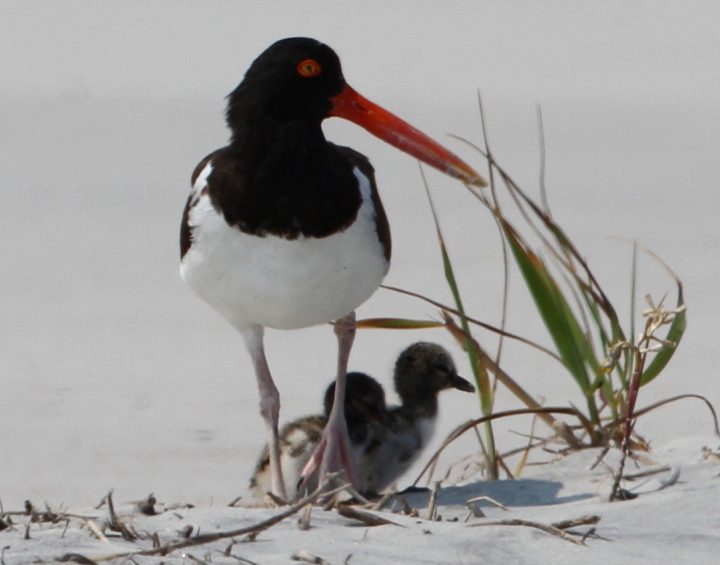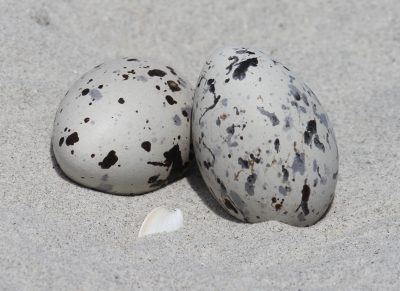
MASONBORO ISLAND – Biologists here recently recaptured a previously banded American oystercatcher, an East Coast and Gulf shorebird. While that’s not unheard of, the bird that is listed as a species of special concern in North Carolina had a leg band placed in 2001 in Georgia.
The discovery of a 17-year-old oystercatcher was exciting news for advocates and conservationists who had worked tirelessly during the past 15 years to bring this wading bird back from near extinction. But despite the encouraging discovery, the species still faces challenges.
Supporter Spotlight
“It’s really tough being an American oystercatcher these days,” said Walker Golder, director of the Atlantic Flyway Coast Initiative at the National Audubon Society. “Oystercatchers are highly susceptible to chronic human disturbance.”
Golder also noted that oystercatchers have faced loss of nesting habitat from beach construction, rising sea levels, ongoing erosion and strong storms, resulting in reduced food resources and increasing animal predation.
Although the distinctively colored wading bird with a large red bill can be seen engaging in its unusual eating habits at intertidal areas on beaches and islands along the North Carolina coast, their numbers have been in serious decline from two centuries of hunting practices.
Studies in the early 21st century showed population losses up to 50 percent. Earlier counts found the bird virtually extinct along the New England coast. Oystercatchers are considered an umbrella species in conservation terms, meaning their reproductive status reflects overall ocean health, making them harbingers of the well-being of all wildlife on North Carolina beaches.

“We will have to act to protect the North Carolina coast for the North Carolina people and for wildlife,” Golder said. “American oystercatchers are susceptible to human disturbance and new predators.”
Supporter Spotlight
Lindsay Addison, a coastal biologist with Audubon North Carolina, said predation can be higher near human development. Animals follow human habitation, which creates greatly increased predation, including dogs, cats and some wildlife.
“Raccoons, for example, prey on eggs and chicks and when there are too many (raccoons) on a barrier island, they can wipe out an entire season’s nesting effort,” Addison said, adding that habitat management has helped increase oystercatchers’ numbers.
A statewide census is carried out every three years with the cooperation of partners around the state including Audubon North Carolina, the national seashores, the state park system and the North Carolina Coastal Reserve System. The most recent count taken in 2016 shows pairs have stabilized and increased, with 435 nesting pairs, Addison said.

“We don’t have counts for 2017, because it’s not a census year in North Carolina, but from nesting monitoring, which goes on every year at some sites, we observe nesting success,” she added.
The increase is largely from stepped-up efforts by Audubon North Carolina, North Carolina Fish and Wildlife Services, the North Carolina Coastal Reserve System, the National Park Service and the American Oystercatcher Working Group, which works to develop, support and implement research and management.
American oystercatchers breed once a year and are considered excellent parents with both adults incubating the eggs and feeding the chicks, which may remain with the parents for up to six months or until their beaks become strong enough to feed for themselves. Oystercatchers eat by stabbing their bill into a partially open oyster, clam or other bivalve and cutting the hinge that allows the clam to close its shell, exposing the remaining soft tissue.
Human encroachment reduces open beach areas and limits nesting sites for oystercatchers. Seawalls are of particular concern because their construction involves the leveling of sand dunes and plant cover, leaving flattened sand plains. Terminal groins and jetties, which disrupt sand flow and food supply, are a similar threat.
American oystercatchers nest on higher ground when they can find it, so with high sand features razed in preparation for sea walls, they can be forced to make their nests near the high-tide line, leaving eggs and chicks vulnerable to sudden rogue waves.
Beach areas open to off-road vehicles often lead to crushed nests, and hard-to-see fledglings can easily be run over. Engine noises can cause frightened oystercatcher parents to abandon their nests.

“Given the threats they face, it’s important we don’t compound oystercatcher problems with human disturbance, which can cause eggs and chicks to fail. Also, respecting signs marking nesting sites and moving away from an area where a bird is upset by pacing, flying up or calling repeatedly should be clues for us to help these birds by respecting their existence,” Golder said.
Included in these efforts is the involvement of local communities in marking nest locations, fencing off nesting areas or making signage to warn beachgoers of the presence of nesting activity. Helping to keep the beach clear of ensnaring human debris and objects such as fishing line and plastics is important as is keeping pets leashed or off the beach areas.
Beachgoers are encouraged to report observed banded birds to Audubon North Carolina, the American Oystercatcher Band Database or to the American Oystercatcher Working Group. The working group’s website lists members to contact regarding banded birds or problems observed. The public’s help can be crucial for the species.
“There has been an accelerated erosion of beaches,” Golder explained. “And we will have to adapt to future conditions on the coast. Ignoring these problems is not an option. We need management, restoration and sustainability if the American oystercatchers are to survive.”







